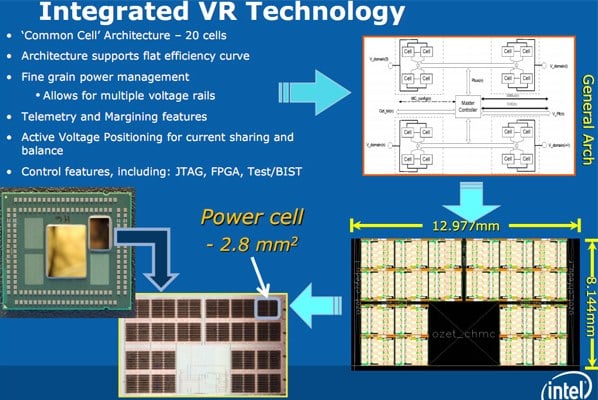Intel's Haswell Takes A Major Step Forward, Integrates Voltage Regulator
For the past decade, AMD and Intel have been racing each other to incorporate more components into the CPU die. Memory controllers, integrated GPUs, northbridges, and southbridges have all moved closer to a single package, known as SoCs (system-on-a-chip). Now, with Haswell, Intel is set to integrate another important piece of circuitry. When it launches next month, Haswell will be the first x86 CPU to include an on-die voltage regulator module, or VRM.

If the idea rings a dim bell, it should. This is an approach Intel first discussed back in 2005 during IDF. At the time, the company showed off a Pentium M 738 with a CMOS voltage regulator on-package and claimed that this allowed the company to save large amounts of power by shifting to low power states much more quickly. In 2005, the technology was nowhere near ready for primetime. Now, it is.
Boosting The Race To Zero:

Haswell incorporates a refined VRM on-die that allows for multiple voltage rails and controls voltage for the CPU, on-die GPU, system I/O, integrated memory controller, as well as several other functions. Intel refers to this as a FIVR (Fully Integrated Voltage Regulator), and it apparently eliminates voltage ripple and is significantly more efficient than your traditional motherboard VRM. Added bonus? It's 1/50th the size.

The good news is that this technique should allow Haswell to draw less power than Ivy Bridge. It'll enter and exit power-saving states more quickly, which allows for more aggressive throttling, and it should run extend system battery life.
The bad news is that building the FIVR on die may hurt CPU temps and overclocking at higher clock speeds. According to leaked (but trustworthy) spec sheets, the upcoming HD 4770K series holds the line on base and turbo clock speeds compared to the 3770K, but increases TDP to 84W, up from 77W. That increase is likely driven by incorporating the FIVR. That doesn't mean the system's power consumption has changed, but a component that used to exist in a separate domain is now being cooled by the CPU heatsink+fan and sits within the same socket.

Whether this ends up shortchanging the CPUs overclocking performance isn't clear yet. Theoretically, the FIVR could become a hot spot under increased load, which would sharply limit OC capability. What's more certain is that the FIVR design is a definite step forward for notebooks, tablets, and smartphones. Haswell is debuting the technology -- we don't know if it's incorporated into the upcoming Silvermont hardware -- but if it works here, it'll be adopted for other products. Long-term, these are the sorts of innovations that'll pry open markets that were traditionally closed to x86 due to high power consumption.

If the idea rings a dim bell, it should. This is an approach Intel first discussed back in 2005 during IDF. At the time, the company showed off a Pentium M 738 with a CMOS voltage regulator on-package and claimed that this allowed the company to save large amounts of power by shifting to low power states much more quickly. In 2005, the technology was nowhere near ready for primetime. Now, it is.
Boosting The Race To Zero:

Haswell incorporates a refined VRM on-die that allows for multiple voltage rails and controls voltage for the CPU, on-die GPU, system I/O, integrated memory controller, as well as several other functions. Intel refers to this as a FIVR (Fully Integrated Voltage Regulator), and it apparently eliminates voltage ripple and is significantly more efficient than your traditional motherboard VRM. Added bonus? It's 1/50th the size.

The good news is that this technique should allow Haswell to draw less power than Ivy Bridge. It'll enter and exit power-saving states more quickly, which allows for more aggressive throttling, and it should run extend system battery life.
The bad news is that building the FIVR on die may hurt CPU temps and overclocking at higher clock speeds. According to leaked (but trustworthy) spec sheets, the upcoming HD 4770K series holds the line on base and turbo clock speeds compared to the 3770K, but increases TDP to 84W, up from 77W. That increase is likely driven by incorporating the FIVR. That doesn't mean the system's power consumption has changed, but a component that used to exist in a separate domain is now being cooled by the CPU heatsink+fan and sits within the same socket.

Whether this ends up shortchanging the CPUs overclocking performance isn't clear yet. Theoretically, the FIVR could become a hot spot under increased load, which would sharply limit OC capability. What's more certain is that the FIVR design is a definite step forward for notebooks, tablets, and smartphones. Haswell is debuting the technology -- we don't know if it's incorporated into the upcoming Silvermont hardware -- but if it works here, it'll be adopted for other products. Long-term, these are the sorts of innovations that'll pry open markets that were traditionally closed to x86 due to high power consumption.

